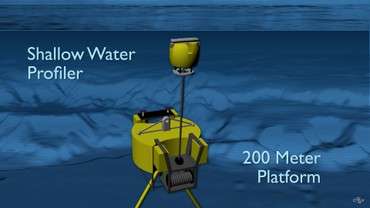Novel scientific equipment will unlock ocean secrets for decades

(Phys.org) -- Like a seal that dives into the water over and over feeding on fish, sometime in the not-too-distant future sophisticated scientific equipment will start traveling from the ocean's surface to 650 feet deep as often as eight times a day.
Along the way it will collect important data about ocean properties including currents, microorganisms and temperature, sending the information in real time to scientists sitting comfortably in their offices--and with updates it will do this for 25 years.
In April, a team of eight engineers who work at the University of Washington’s Applied Physics Laboratory submitted designs for this water column profiling system to the Consortium of Ocean Leadership, which is managing a National Science Foundation project to supply sustained ocean measurements to scientists around the world for decades. The UW, one of several institutions working as part of the Ocean Observatories Initiative, is charged with designing and building the first U.S. regional cabled ocean observatory, which will be located off the coast of Oregon. The water column profiling equipment is part of that system.
As with the entire cabled observatory network, there is much about the equipment that is unprecedented. Other instruments used to collect data about oceans survive only a few years. Some only send data periodically or when scientists can retrieve them from the ocean.
“This is a really special thing,” said Geoff Cram, an engineer at the Applied Physics Lab who helped design the profiling system.
It is comprised of a floating platform about 650 feet below the surface and tethered to the ocean floor, nearly two miles under water. Attached to the platform is the profiler equipment which will float to the surface and get pulled back down by a winch.
Via the Internet, scientists will be able to remotely program the profiler to travel on different schedules. For instance, researchers may want the profiler to “stop and loiter,” collecting data from as many as 15 sensors over a period of time at a certain depth, Cram said.
Even the cable that connects it to the winch is special. Inside it are wires that carry power from the main seafloor cable to the shallow profiler and that connect it to the Internet, Cram said. When one of the instruments on the shallow profiler picks up data, it transmits it over the Internet in real time so that scientists--or anyone with an Internet connection--can access it from land.
Much of the equipment will last for decades underwater because it is fabricated from titanium, the ultrastrong, lightweight metal that is also highly resistant to corrosion. But not every component will last that long. Some, like sensors, will wear out over time and be replaced.
Having the cabled observatory permanently in place and constantly collecting data is incredibly important for science, said Kendra Daly, a UW alum and oceanographer with the University of South Florida who is helping develop the Ocean Observatories Initiative project.
“This is ground breaking,” she said
Many events in the ocean, like storms, are episodic and scientists either can’t get to the area to deploy instruments or they aren’t able to predict the specific event.
Other ocean processes change slowly over long periods of time and scientists need continuous measurements to study them.
“We know the ocean is changing, but we need high-frequency, continuous measurements over long periods of time to really understand it,” Daly said.
The instruments on the shallow profiler will measure things like temperature, salinity, currents, oxygen, carbon dioxide and pH (ocean acidity).
Oceanographers from UW and other institutions collaborated closely with the engineers to design the profiler. During the planning phase, oceanographers determined the science requirements for the system. Now during the construction phase, the engineers are working closely with scientists to implement the envisioned system.
Cram and his team are now resolving final questions identified during the recent review and are just starting to build the system. They hope to begin testing their profiler in about six months. Deployment on the cabled network is scheduled for 2014.
The investment by the NSF in the Ocean Observatories Initiative, including construction and 25 years of operations, could reach $769.5 million. The UW is expected to receive nearly $235 million for design and construction of the underwater network and for initial instrumentation and operations.
Led by Professor John R. Delaney in the UW School of Oceanography, the observatory now being constructed comprises 560 miles of underwater fiber-optic cable as well as scientific instrumentation like the shallow water profiler. The observatory's cabled network connects to shore in Pacific City, Oregon.
Other Ocean Observatories Initiative sites around the world will also collect ocean data at critical locations. The overall goal of the initiative is to build an infrastructure that will transform the studies of issues including climate variability, ocean circulation, air-sea exchange and geodynamics over entire tectonic plates.
Provided by University of Washington


















